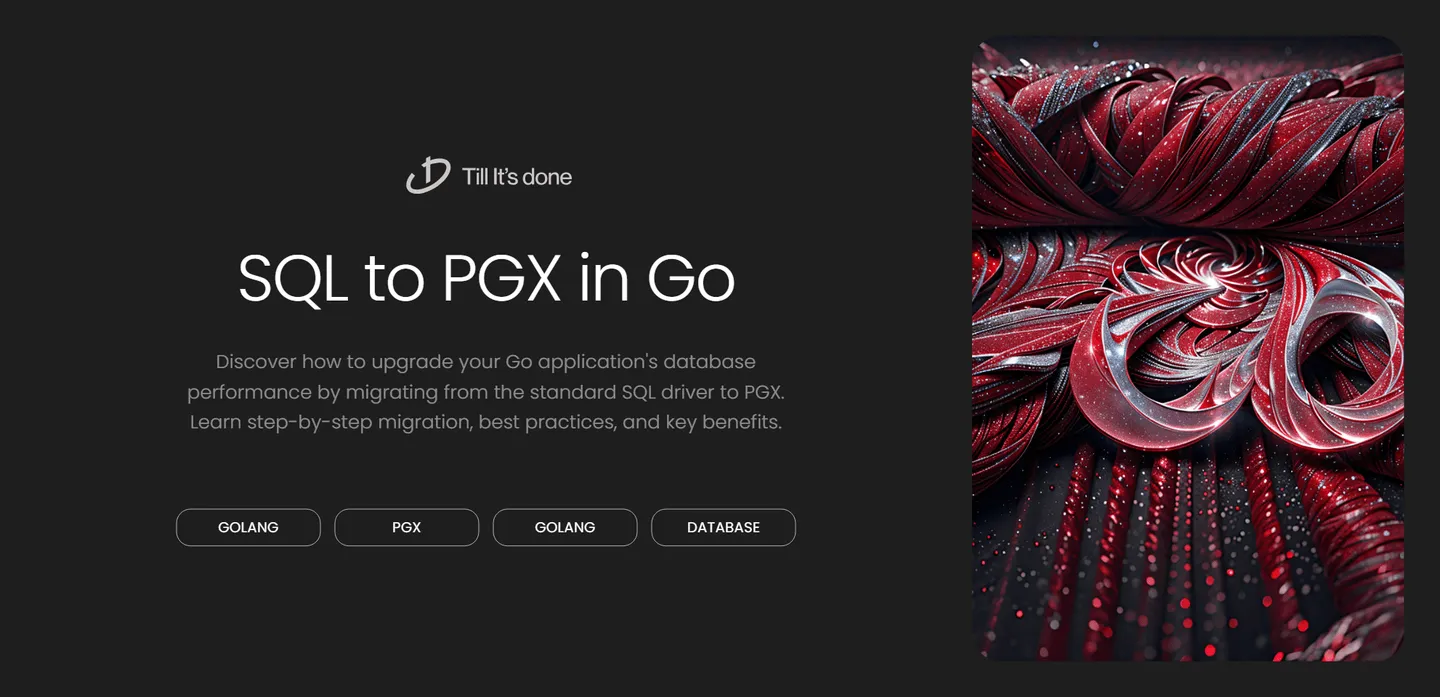- Services
- Case Studies
- Technologies
- NextJs development
- Flutter development
- NodeJs development
- ReactJs development
- About
- Contact
- Tools
- Blogs
- FAQ
Migrate from SQL Driver to PGX in Golang
Learn step-by-step migration, best practices, and key benefits.

Migrating from Standard SQL Driver to PGX in Golang: A Journey to Better Database Performance

Are you still using the standard database/sql package with lib/pq for your PostgreSQL operations in Go? While it’s served us well, there’s a more powerful alternative that could significantly improve your application’s performance: pgx. Let’s explore why and how to make this transition.
Why Consider PGX?
The journey from the standard SQL driver to pgx is like upgrading from a reliable sedan to a high-performance sports car. PGX brings several compelling advantages:
- Better performance with optimized PostgreSQL-specific protocols
- Native support for more PostgreSQL data types
- Built-in connection pooling
- Automatic prepared statement caching
- Batch operations support
- Enhanced error handling

Making the Switch: Step-by-Step Migration
1. Update Dependencies
First, let’s update our dependencies. Remove the old one and bring in the new:
// Remove this_ "github.com/lib/pq"
// Add these"github.com/jackc/pgx/v4""github.com/jackc/pgx/v4/pgxpool"2. Connection String Updates
PGX uses a slightly different connection string format. Here’s how to modify it:
// Old style// "postgres://username:password@localhost:5432/dbname?sslmode=disable"
// New style// "postgres://username:password@localhost:5432/dbname"3. Establishing Connections
The connection setup changes from using sql.Open to pgxpool.Connect:
// Beforedb, err := sql.Open("postgres", connString)
// Afterpool, err := pgxpool.Connect(context.Background(), connString)
4. Updating Queries
Most of your existing queries will work with minimal changes. The main difference is the need for context:
// Beforerows, err := db.Query("SELECT * FROM users WHERE active = $1", true)
// Afterrows, err := pool.Query(context.Background(), "SELECT * FROM users WHERE active = $1", true)5. Handling Transactions
Transactions get a slight syntax update but become more straightforward:
// Using pgxtx, err := pool.Begin(context.Background())if err != nil { return err}defer tx.Rollback(context.Background())
// Perform transactionserr = tx.Commit(context.Background())Best Practices and Tips
- Always use connection pooling for better performance
- Leverage batch operations for multiple queries
- Take advantage of pgx’s native PostgreSQL type support
- Use context timeouts for better control over query execution
- Consider using pgx’s copy protocol for bulk insertions
Remember to test thoroughly in a staging environment before deploying to production. The switch to pgx might reveal edge cases in your current code that need attention.

The migration to pgx might seem daunting at first, but the performance benefits and enhanced features make it worth the effort. Take it step by step, and you’ll soon be enjoying a more robust and efficient database interaction in your Go applications.
 Web Developers คืออะไร? สำคัญแค่ไหน Web Developer คืออาชีพที่มีทักษะด้านโปรแกรมมิ่ง และมีการเรียนรู้ในเทคโนโลยีใหม่ ๆ เพื่อพัฒนางานอย่างต่อเนื่อง และมีความสำคัญกับธุรกิจในยุคดิจิตัลแบบนี้เป็นอย่างมาก
Web Developers คืออะไร? สำคัญแค่ไหน Web Developer คืออาชีพที่มีทักษะด้านโปรแกรมมิ่ง และมีการเรียนรู้ในเทคโนโลยีใหม่ ๆ เพื่อพัฒนางานอย่างต่อเนื่อง และมีความสำคัญกับธุรกิจในยุคดิจิตัลแบบนี้เป็นอย่างมาก  จุดเด่นของ React JS คือ ดียังไงกับการทำ Mobile App React JS เป็นไลบรารีที่สนับสนุนการพัฒนาแอปพลิเคชันแบบ Single Page พร้อมรองรับการสร้างแอปบนมือถือด้วย React Native แต่ทำอย่างไร มาดูกันครับ
จุดเด่นของ React JS คือ ดียังไงกับการทำ Mobile App React JS เป็นไลบรารีที่สนับสนุนการพัฒนาแอปพลิเคชันแบบ Single Page พร้อมรองรับการสร้างแอปบนมือถือด้วย React Native แต่ทำอย่างไร มาดูกันครับ  Flutter คืออะไร ฟรีมั้ย การพัฒนาแอปพลิเคชันในยุคดิจิทัลนี้ Flutter ได้กลายเป็นหนึ่งในเครื่องมือที่ได้รับความนิยมอย่างมากในวงการ แล้ว Flutter คืออะไร แล้วใช้งานฟรีหรือไม่?
Flutter คืออะไร ฟรีมั้ย การพัฒนาแอปพลิเคชันในยุคดิจิทัลนี้ Flutter ได้กลายเป็นหนึ่งในเครื่องมือที่ได้รับความนิยมอย่างมากในวงการ แล้ว Flutter คืออะไร แล้วใช้งานฟรีหรือไม่?  อยากสร้าง Mobile App จะเลือกใช้โปรแกรมเขียน Mobile App การเลือกโปรแกรมเขียน Mobile App มีเครื่องมือกับภาษาอะไรให้เลือกใช้งานกันมากมาย ควรพิจารณาอย่างไรเพื่อให้มีประสิทธิภาพและตรงตามความต้องการของโปรเจกต์
อยากสร้าง Mobile App จะเลือกใช้โปรแกรมเขียน Mobile App การเลือกโปรแกรมเขียน Mobile App มีเครื่องมือกับภาษาอะไรให้เลือกใช้งานกันมากมาย ควรพิจารณาอย่างไรเพื่อให้มีประสิทธิภาพและตรงตามความต้องการของโปรเจกต์  Next.js คืออะไร? มาเริ่มเขียนเว็บด้วย Next.js กันดีกว่า Next.js เป็น Framework สำหรับสร้างเว็บไซต์ด้วย React ที่ช่วยให้สามารถสร้างเว็บไซต์ที่มีประสิทธิภาพและใช้งานได้จริง และรองรับ SEO ได้ดีขึ้นอีกด้วย
Next.js คืออะไร? มาเริ่มเขียนเว็บด้วย Next.js กันดีกว่า Next.js เป็น Framework สำหรับสร้างเว็บไซต์ด้วย React ที่ช่วยให้สามารถสร้างเว็บไซต์ที่มีประสิทธิภาพและใช้งานได้จริง และรองรับ SEO ได้ดีขึ้นอีกด้วย  รู้จักกับ บริษัท Software House คืออะไร ทำอะไรบ้าง Software House คือศูนย์บริการที่ครบวงจรในการพัฒนาเทคโนโลยี ช่วยสนับสนุนธุรกิจในยุค 4.0 และสร้างโอกาสใหม่ ๆ ในตลาดการแข่งขันที่มีการเปลี่ยนแปลงอย่างรวดเร็ว
รู้จักกับ บริษัท Software House คืออะไร ทำอะไรบ้าง Software House คือศูนย์บริการที่ครบวงจรในการพัฒนาเทคโนโลยี ช่วยสนับสนุนธุรกิจในยุค 4.0 และสร้างโอกาสใหม่ ๆ ในตลาดการแข่งขันที่มีการเปลี่ยนแปลงอย่างรวดเร็ว Talk with CEO
We'll be right here with you every step of the way.
We'll be here, prepared to commence this promising collaboration.
Whether you're curious about features, warranties, or shopping policies, we provide comprehensive answers to assist you.


